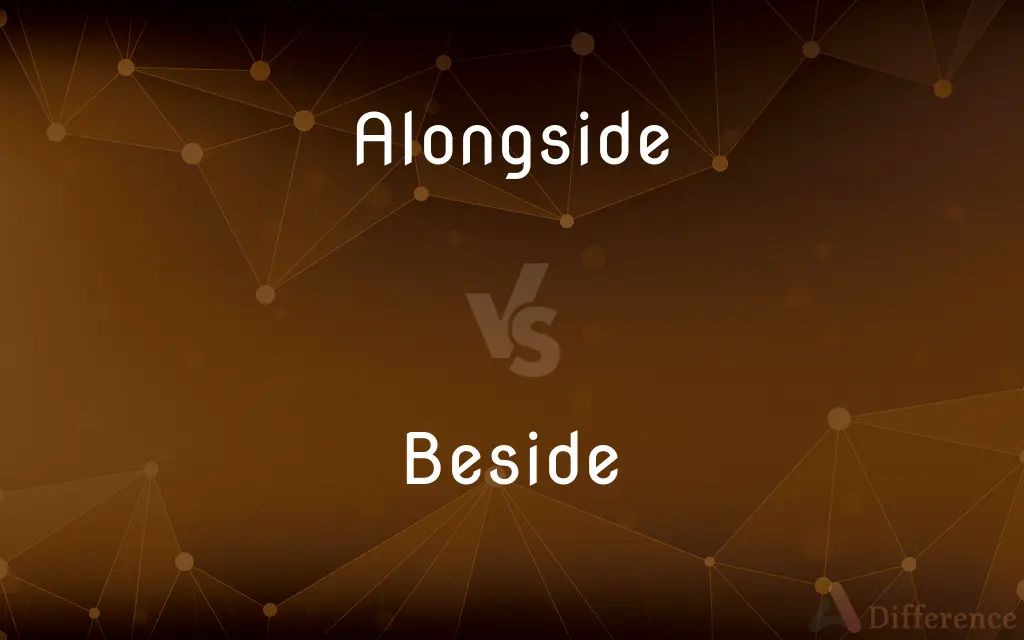Alongside vs. Beside — What's the Difference?
By Maham Liaqat & Fiza Rafique — Updated on March 14, 2024
"Alongside" means next to something or someone, often implying length or movement, while "beside" means at the side of something or someone, emphasizing proximity without the implication of movement.

Difference Between Alongside and Beside
Table of Contents
ADVERTISEMENT
Key Differences
"Alongside" is often used to describe something or someone that is next to and parallel to another, typically implying a considerable length or movement together. For instance, when you walk alongside a river, you are moving in a direction parallel to the river’s course. On the other hand, "beside" is used to indicate something or someone that is at the side of another, focusing more on the position rather than movement or length. For example, placing a book beside a lamp on a table suggests the book is next to the lamp without any implication of movement.
"Alongside" can also imply being together or in association with someone, suggesting partnership or collaboration. For example, working alongside a colleague means collaborating closely with them. "Beside", in contrast, is more static, indicating proximity or placement without suggesting partnership or movement. It’s often used in contexts that emphasize spatial relationships rather than actions or processes.
In usage, "alongside" conveys a sense of companionship or alignment, as in entities moving together or being positioned longitudinally with respect to each other. "Beside" is more straightforward, used to describe the simple fact of one thing being next to another, making it common in descriptions of static scenes or arrangements.
Despite their differences, both words serve to express relationships of proximity but are chosen based on the context—whether the emphasis is on movement and alignment ("alongside") or mere spatial relation ("beside").
Comparison Chart
Meaning
Next to, often implying length or movement.
At the side of, emphasizing proximity.
ADVERTISEMENT
Implication
Suggests partnership, collaboration, or alignment.
Focuses on spatial relationship, without implying movement.
Usage
Used when describing parallel movement or lengthy proximity.
Used to describe proximity or placement without movement.
Context
Often involves actions, processes, or companionship.
Typically involves static positions or spatial arrangements.
Example
Walking alongside a river.
Placing a book beside a lamp.
Compare with Definitions
Alongside
Parallel to something or someone, with an emphasis on length or alignment.
The new bike path runs alongside the highway for ten miles.
Beside
At the side of; immediately adjacent without implying movement.
The teacher stood beside the whiteboard, explaining the lesson.
Alongside
Reflecting partnership or support.
The community groups worked alongside the local government to improve the park.
Beside
Indicates proximity or closeness in a stationary context.
He placed his coffee cup beside the morning paper on the kitchen table.
Alongside
Used to describe things or people in line with each other.
The soldiers marched alongside each other during the parade.
Beside
Used to compare or contrast two things or ideas.
Beside her own concerns, she felt her friend's issues were minor.
Alongside
Conveying the idea of being adjacent to something in a moving or dynamic context.
The dolphins swam alongside the boat, delighting the passengers.
Beside
Often used in expressions to convey support or companionship in a static sense.
In times of trouble, it's good to have a friend beside you.
Alongside
In company with or at the same time as something or someone.
She worked alongside renowned scientists on the project.
Beside
Denotes being on the side, often used in spatial descriptions.
She sat beside him during the concert, enjoying the music together.
Alongside
Along, near, at, or to the side
Stood with a bodyguard alongside.
Drove up alongside.
Beside
At the side of; next to
The table beside the bed
He sat beside me in the front seat
Alongside
By the side of; side by side with
The boat lay alongside the pier.
Beside
In addition to; apart from
He commissioned work from other artists beside Minton
Alongside
Side by side with.
Beside
At the side of; next to.
Alongside
Together with or at the same time.
The nurse worked alongside the doctor.
Beside
In comparison with
A proposal that seems quite reasonable beside the others.
Alongside
Along or by the side; side by side with; - often with of; as, bring the boat alongside; alongside of him; alongside of the tree.
Beside
On an equal footing with
Has earned a place beside the best performers in the business.
Alongside
Side by side;
Anchored close aboard another ship
Beside
In addition to
"Many creatures beside man live in communities" (Stuart Chase). See Usage Note at besides.
Beside
Except for. See Usage Note at besides.
Beside
Not relevant to
A remark that was beside the point.
Beside
In addition.
Beside
Nearby.
Beside
Next to; at the side of.
A small table beside the bed
Beside
Not relevant to.
That is beside the point
Beside
Besides; in addition.
Beside
Otherwise; else; besides.
Beside
At the side of; on one side of.
Beside
Aside from; out of the regular course or order of; in a state of deviation from; out of.
[You] have done enoughTo put him quite beside his patience.
Beside
Over and above; distinct from; in addition to.
Wise and learned men beside those whose names are in the Christian records.
Paul, thou art beside thyself.
Lovely Thais sits beside thee.
Only be patient till we have appeasedThe multitude, beside themselves with fear.
It is beside my present business to enlarge on this speculation.
Besides this, there are persons in certain situations who are expected to be charitable.
And, besides, the MoorMay unfold me to him; there stand I in much peril.
That man that does not know those things which are of necessity for him to know is but an ignorant man, whatever he may know besides.
Common Curiosities
In what contexts is "alongside" preferred over "beside"?
"Alongside" is preferred when describing scenarios that involve parallel movement, lengthwise proximity, or collaboration, emphasizing a more dynamic or extensive relationship.
Can "alongside" be used to describe relationships beyond physical proximity?
Yes, it can describe collaborative relationships or simultaneous occurrences, like adopting new technologies alongside traditional methods.
Can "alongside" and "beside" be used interchangeably?
While they can sometimes be used interchangeably in casual conversation, their nuances mean they're often chosen for specific contexts to convey movement or static proximity accurately.
Can "beside" imply a lower level of intimacy than "alongside"?
Potentially, as "beside" focuses on spatial relationship without the dynamic connotations of partnership or movement that "alongside" might imply.
Is "beside" only used for physical proximity?
Primarily, yes, but it can also be used metaphorically to compare or contrast things or ideas.
What scenarios best illustrate the use of "alongside"?
Scenarios involving movement, such as walking alongside a road, or partnership, such as working alongside team members on a project.
How does the choice between "alongside" and "beside" affect the tone of a sentence?
"Alongside" can add a dynamic or collaborative tone, whereas "beside" tends to convey a more static or simple proximity, affecting the sentence's emphasis and mood.
Does the use of "beside" in a sentence always require a physical object?
While commonly used to refer to physical proximity, "beside" can also be used metaphorically or in idiomatic expressions.
Are there instances where "beside" and "alongside" are not interchangeable, even casually?
Yes, especially when the specific implications of movement (with "alongside") or static proximity (with "beside") are crucial to the sentence's meaning, they cannot be swapped without altering the sentence's intent.
What are some common mistakes when choosing between "alongside" and "beside"?
Misusing "alongside" to describe stationary proximity or using "beside" where the context implies movement or partnership can lead to confusion about the intended meaning.
Does "alongside" imply equality or partnership?
It can suggest partnership, collaboration, or alignment, especially when referring to working or moving together with someone or something.
Is "alongside" suitable for use in formal writing?
Yes, "alongside" is appropriate in formal contexts, especially when describing partnerships, collaborations, or parallel developments.
When is "beside" the better word choice in a sentence?
When indicating a static position or proximity without movement, such as sitting beside a friend or placing an item beside another.
How does "beside" function in comparative expressions?
It can be used to make comparisons or highlight contrasts, as in "beside the point" or when comparing the importance of two different matters.
Can "alongside" imply competition as well as cooperation?
Primarily, "alongside" implies cooperation or parallelism, but it can be used in contexts where entities are in competition yet moving together in the same direction or market.
Share Your Discovery

Previous Comparison
Bring vs. Take
Next Comparison
Blood vs. LymphAuthor Spotlight
Written by
Maham LiaqatCo-written by
Fiza RafiqueFiza Rafique is a skilled content writer at AskDifference.com, where she meticulously refines and enhances written pieces. Drawing from her vast editorial expertise, Fiza ensures clarity, accuracy, and precision in every article. Passionate about language, she continually seeks to elevate the quality of content for readers worldwide.














































